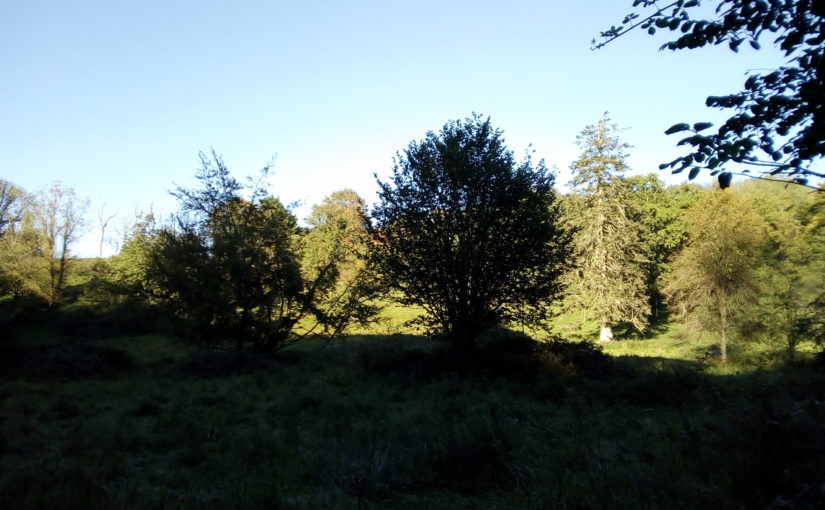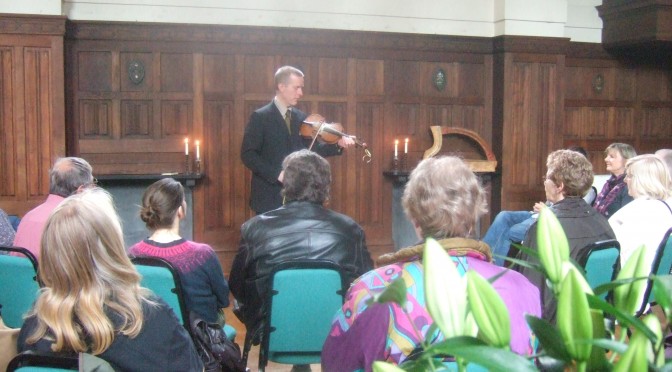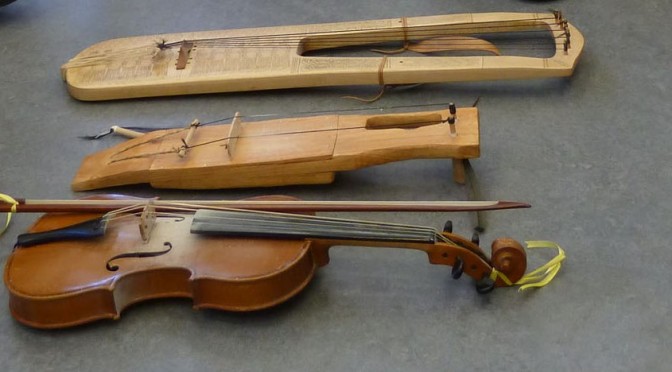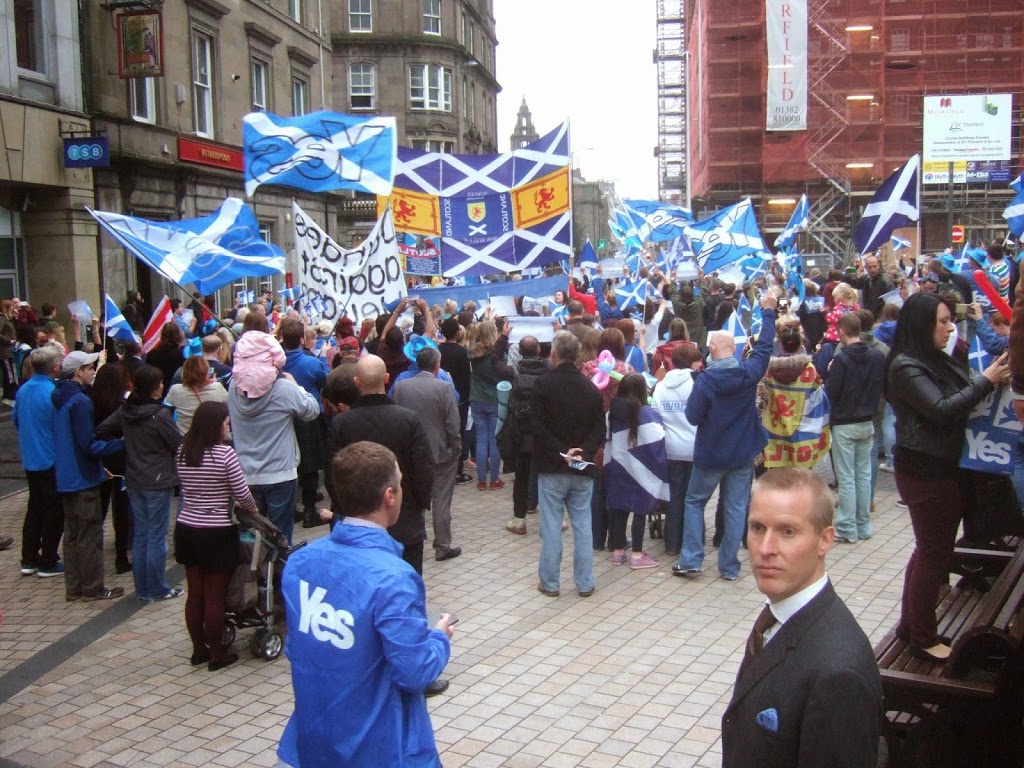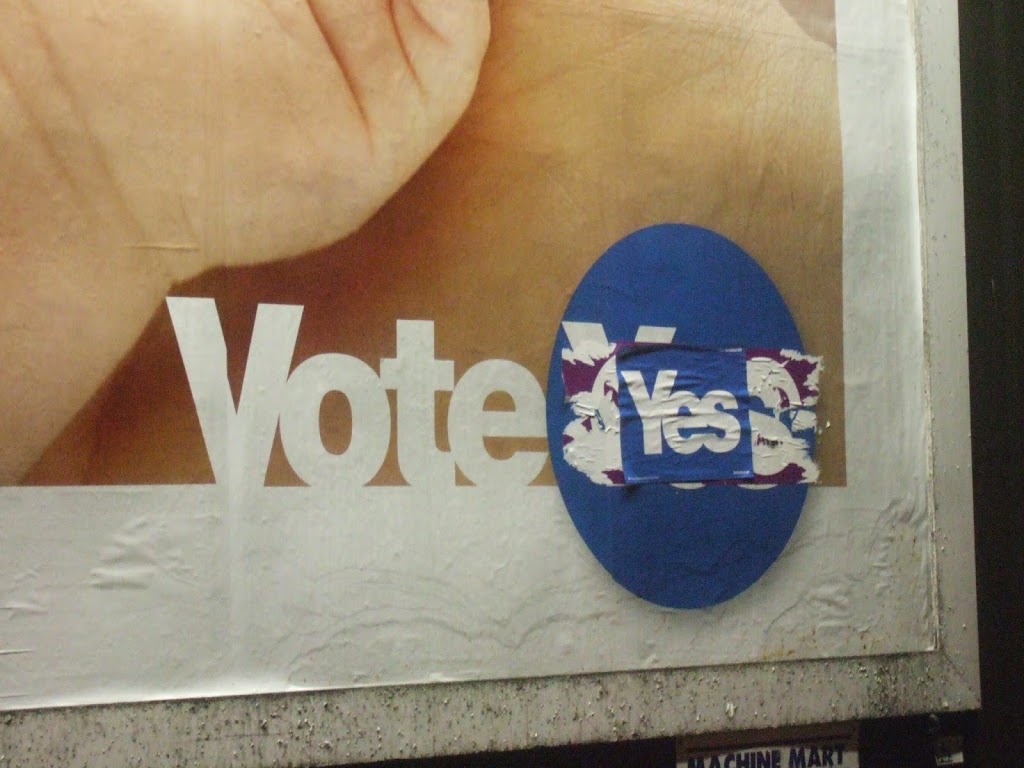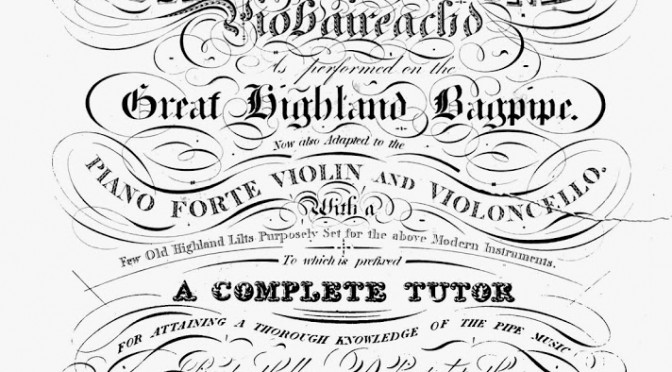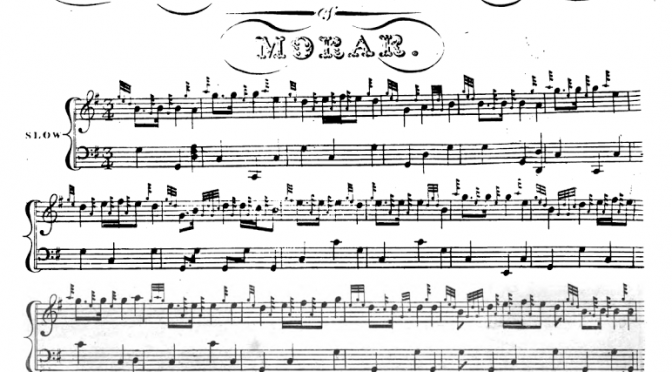One reason it has taken me a long time to get to my next tune is that there are a lot of pages in Queen’s University Belfast, Special Collections, MS4.29 which I have skipped. There is a big section of mostly or entirely Denis O’Hampsey material from pages 164 to 172, which I am skipping because I am concentrating on the other harpers. Then there are two sections which don’t seem to be harp transcriptions. I am less certain about identifying what these are, since my focus has been on spotting the harp style and idiom.
Continue reading Two difficult sectionsTag: fiddle
Playing a fiddle tune
At today’s concert in All Saints Church Hall, I played Cumha Raonuill Mhic Ailein Òig on the fiddle, as part of my new programme “The contest betwixt fiddle & harp”. I was very nervous to present the fiddle in public but it seemed to go down very well.
Bowed-harp workshop
Yesterday I was in Edinburgh to present my “bowed lyre workshop” at the Northern Streams festival.
In Dundee on the eve of the Referendum
Last night we went to Dundee, as I was performing my concert on board the Unicorn. We travelled in early just so we could have an hour or so wandering around the centre of town to see if anything was happening.
In city square there were perhaps a thousand people with flags and music, very peaceful and friendly, lots of family groups. They organised a procession around the block, so we followed on at the end.
We left the gathering and headed down to the docks. The Unicorn is a really beautiful ship, genuinely old and not over-manicured like many historical things. On board, the captains cabin had been cleared and was set with chairs; the wine was laid out on a table ouside the cabin entrance, on the main deck. The ceilings on board are very low!
As it got dimmer, people started arriving. There was not a huge turnout, but the low ceilings and the homely atmosphere of the ship seemed to draw people out; everyone was talking to each other in unexpected intimacy.
For the first half of the concert, I played a selection of 18th century music, from the pibroch Maol Donn to the breezy baroque Blossom of the Raspberry. My fiddle tune went OK and was well received – especially with the story about it.
In the interval everyone went into the main deck for wine and conversation. This went on for quite a long time!
Then for the second half I played the Lament for the Union set. People were interested and sympathetic to the sentiments – it felt like a historic moment, thinking about the beginning of the Union in 1707, on the eve of the historic referendum to undo it. Especially with the evening glow from the docks through the windows…
Walking back up through the town late at night to the bus station to catch our ride home, we saw a battle of the billboards. Looks like Yes is winning this one!
Forthcoming events
As well as doing some work canvassing for the referendum, I have been preparing for a couple of forthcoming events in Dundee. On Wednesday 1st October I am presenting Scottish music 78s for the Wighton lunchtime concert, though more imminent is my concert on Wednesday 17th September, on the eve of the referendum. I’m playing the harp in the elegant and unusual setting of the captain’s cabin on board HMS Unicorn, moored in Dundee docks. This classy wood-panneled room will be a lovely setting for the replica Queen Mary harp. There will be an interval with a glass of wine, and for the second half I am planning to play my “Lament for the Union” programme.
For the first half though, I am thinking of continuing the “300 years ago” theme with a selection of 18th century harp music. Normally I use the Downhill harp for that, but I know the Dundee people love the Queen Mary replica, and I only recently commandeered the Downhill back from my student who has it, so I am thinking laterally. Perhaps one of the ports played by John Robertson on the original Queen Mary harp in the early 1700s will allow me to joke about “Port Athol, Port Gordon and Port Seton” given the nautical setting!
I am also thinking that, as I always like to in a longer performance, I should pull something completely different out as a novelty and so I am thinking of playing a tune on the fiddle. Port na bPucaí has a suitable marine story to go with it and I think might be a nice suprise item. I just have to practice enough to be able to play it convincingly! We’ll see if my resolve can hold until next week!
Playing ceòl mór from Donald MacDonald’s 1820 printed book
I am intrigued by Donald MacDonald’s arrangements of ceòl mór or pibroch, because on his title page he indicates that he is not setting out the tunes in “pipers tablature”, that cryptic system that looks confusingly similar to staff notation; instead, he describes his work:
A / collection / of the / Ancient Martial / Music of Caledonia / called / Piobaireachd / as performed on the / Great Highland Bagpipe / Now also adapted to the / Piano Forte, violin and violoncello…
By setting the music on two staves, treble and bass, he intends that the purchasers of his book, price one guinea (£1 1s, or a few hundred pounds in today’s money) to play this music not on the pipes (what wealthy, musically literate book-buyer in 1820 owned or played pipes?) but on the piano; if they had musical guests at their Edinburgh townhouse they may well also try it as violin and cello duets.
Donald writes a single bass line very simply in the bass clef, which looks to me quite old-fashioned for 1820; I think by that date many music arrangers were writing chordal and thicker textures in the bass. On the other hand the modal, drone-based nature of the music may have discouraged anything more complex.
He writes the melody in a more nuanced way, setting the tune in large notes with their stems all pointing down, and using little notes with the stems up to indicate the characteristic bagpipe grace-notes. I imagine he expected piano and fiddle players to ignore these in performance, but to appreciate them as exotic talking-points read in connection with the “instructions” at the beginning of the book.
How did he decide which notes to make big, and which small? This is the vexed question of all early pibroch scholarship, since there seems to have been a strong movement through the 19th and 20th century to shift the musical emphasis in a big way, with melody notes becoming swallowed up into bundles of gracenotes, and rogue grace notes being held so long that they speak as stressed melody notes.
My opinion is that he wrote the big notes so that when played normally on the fiddle or piano, the melody sounded as he imagined in his head that it should, based on his knowledge of the expected traditional expression of this tune on the pipes (and perhaps also on the fiddle, seeing as the fiddle pibroch tradition may have still been reasonably strong at this time)
Cumha Raonuill Mhic Ailein Òig
Today I have been working on Cumha Raonuill Mhic Ailein Òig, the Lament for Ronald MacDonald of Morar. It is working very nicely as a fiddle tune. I am following Donald MacDonald’s 1820 printed arrangement:
It continues for three more pages with the variations; so far I have been concentrating on the first variation and its doubling. Donald MacDonald’s setting is strangely assymetrical with startling developments of the melody in the second half of the tune; Angus MacKay’s manuscript seems to be the same though I don’t know if MacKay was just copying MacDonald or whether he had the tune independently from oral tradition. All the later sources hack about with it and remove bars to make it four-square and much less dramatic.
I’m tuning the fiddle a-e’-a’-e” (though as usual I keep it one note lower than modern pitch), as this allows the tune to be played mainly on the two highest strings, with the two lowest acting as intermittent drones. I’m finding this tune sits very well on the fiddle, with pleasant string-crossings and open intervals.
I’m not planning to play this on the harp, out of respect for Ranald – if he was, as tradition says, one of the last of the old harpers, whoever composed this fine lament after he died would not have been a harper, though they may well have played fiddle as well as pipes.
Hopefully I will put up a Youtube of it at some point though I already have a backlog of things to record!
Port na bPúcaí
Irish piper Ronan Browne played at the three HHSI concerts, in Kilkenny, Galway and Dublin last week. One of the tunes he played on his more modern set of pipes was Port na bPúcaí, a most amazing slow air. I already knew that Ronan did a lot of work with archive recordings, and he mentioned that this tune was transmitted via a single archive recording, a fiddle performance by Seán Cheaist Ó Catháin which was released on a CD, Beauty an Oileáin: Music and Songs of the Blasket Islands (Claddagh CC56CD, 1992).
Seán Cheaist’s performance is very interesting and beautiful and I have spent today learning to play it on the fiddle. It has an interesting structure, with repeating phrases having “open” or “closed” endings – you could indicate it as A1 A2 B1 B2 B1 A2 – meaning that the second half is twice as long as the first. The 7th note of the scale is deliciously ambiguous – it tends towards either the flat or sharp 7th at different points of the tune, but never quite gets to either.
